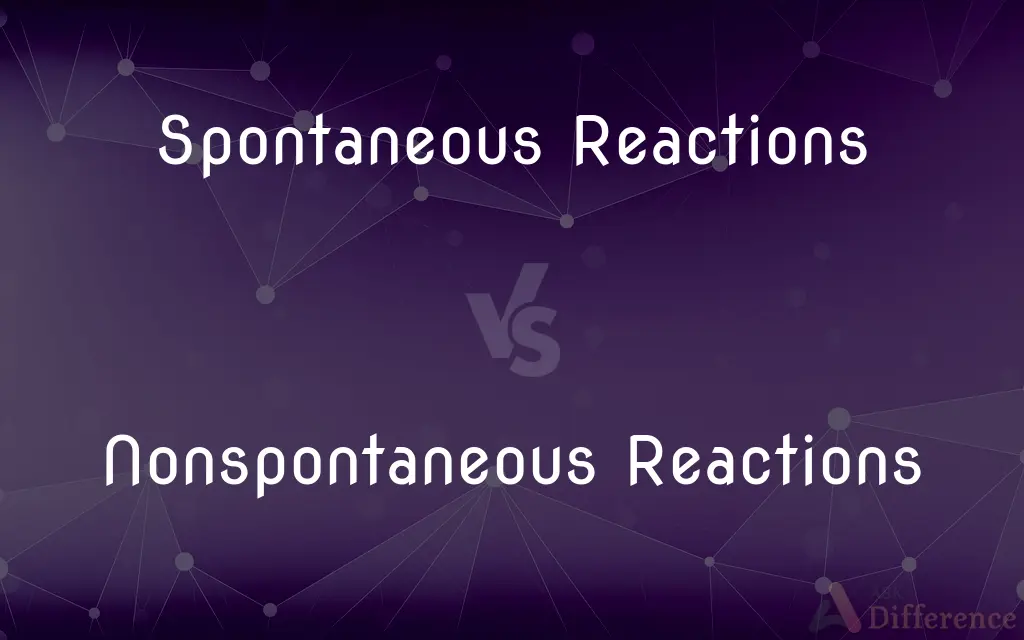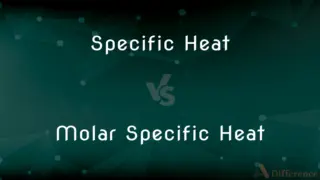Spontaneous Reactions vs. Nonspontaneous Reactions — What's the Difference?
By Tayyaba Rehman — Published on December 10, 2023
Spontaneous Reactions occur naturally without external input, while Nonspontaneous Reactions require external energy to proceed.

Difference Between Spontaneous Reactions and Nonspontaneous Reactions
Table of Contents
ADVERTISEMENT
Key Differences
Spontaneous Reactions and Nonspontaneous Reactions are terms used to categorize chemical reactions based on their natural tendency to occur. Spontaneous Reactions are those reactions that can occur without any external intervention. They tend to move towards a state of lower energy or increased disorder. This does not necessarily mean that Spontaneous Reactions are swift; some can be quite slow. However, the driving force for these reactions exists inherently due to the nature of the reactants and the conditions.
Nonspontaneous Reactions, in contrast, are those reactions that do not occur on their own under a set of conditions. They require an external source of energy to proceed. This energy can come in various forms, such as heat, light, or electricity. Nonspontaneous Reactions might be desired in various scenarios, but the push to make them occur must be externally provided.
The thermodynamic feasibility of Spontaneous Reactions and Nonspontaneous Reactions can often be determined by the Gibbs free energy change (∆G). If ∆G is negative, the reaction tends to be spontaneous, whereas if ∆G is positive, the reaction is typically nonspontaneous under standard conditions. However, it's crucial to note that even if a reaction is spontaneous thermodynamically, it might not be kinetically favorable, meaning it might need a catalyst or a particular condition to speed up the process.
Another noteworthy point is the reversibility of these reactions. While Spontaneous Reactions tend to move in a specific direction naturally, reversing them would typically result in Nonspontaneous Reactions. Conversely, making a Nonspontaneous Reaction proceed might be spontaneous in the reverse direction. These tendencies significantly impact various industrial and natural processes, as they determine the energy and resources needed for specific chemical transformations.
Comparison Chart
Natural Occurrence
Occur naturally without external input
Require external energy to proceed
ADVERTISEMENT
Gibbs Free Energy Change (∆G)
Typically negative (∆G < 0)
Typically positive (∆G > 0)
Need for Catalyst
Not necessarily needed, but can speed up the reaction
May be needed to initiate or accelerate the reaction
Typical Examples
Combustion, dissolution of salt in water
Electrolysis, synthesis of ammonia under certain conditions
Directionality/Reversibility
Reversing them usually results in Nonspontaneous Reactions
Making them proceed might be spontaneous in the reverse direction
Compare with Definitions
Spontaneous Reactions
Reactions that naturally proceed without external intervention.
The rusting of iron is a slow but Spontaneous Reaction.
Nonspontaneous Reactions
Chemical processes with an inherent energy barrier.
Combining nitrogen and oxygen to form nitrogen dioxide is a Nonspontaneous Reaction at room temperature.
Spontaneous Reactions
Natural chemical occurrences without an energy barrier.
The melting of ice at room temperature is a Spontaneous Reaction.
Nonspontaneous Reactions
Reactions requiring external energy to occur.
The synthesis of diamond from graphite is a Nonspontaneous Reaction.
Spontaneous Reactions
Processes that tend towards increased disorder or lower energy.
Dissolution of sugar in water is a Spontaneous Reaction.
Nonspontaneous Reactions
Chemical transformations not occurring on their own under certain conditions.
Splitting water into hydrogen and oxygen through electrolysis is a Nonspontaneous Reaction.
Spontaneous Reactions
Reactions with a negative Gibbs free energy change.
The formation of water from hydrogen and oxygen is a Spontaneous Reaction.
Nonspontaneous Reactions
Processes opposing a natural tendency or direction.
Converting water vapor directly to ice is a Nonspontaneous Reaction.
Spontaneous Reactions
Chemical transformations driven by inherent forces or conditions.
Combustion of gasoline in a car engine is a Spontaneous Reaction.
Nonspontaneous Reactions
Reactions with a positive Gibbs free energy change.
Certain uphill chemical syntheses in labs are Nonspontaneous Reactions.
Common Curiosities
What drives Spontaneous Reactions?
They are driven by inherent forces, often leading to lower energy states or increased disorder.
What's the role of Gibbs free energy in categorizing reactions?
A negative ∆G suggests spontaneity, while a positive ∆G suggests nonspontaneity under standard conditions.
Is the speed indicative of a reaction's spontaneity?
No, Spontaneous Reactions can be slow, and speed doesn't determine spontaneity.
Can Nonspontaneous Reactions become spontaneous under different conditions?
Yes, changing temperature or pressure can alter spontaneity.
Can Nonspontaneous Reactions be made to happen?
Yes, with external energy or specific conditions.
Do Nonspontaneous Reactions occur on their own?
No, they require external energy or conditions to proceed.
How are Spontaneous Reactions related to entropy?
They often lead to an increase in entropy (disorder).
Is a catalyst essential for Spontaneous Reactions?
No, but it can speed up their rate.
Can reversing a Spontaneous Reaction lead to a Nonspontaneous Reaction?
Often, yes. The reverse process might require external energy.
Can a catalyst turn a Nonspontaneous Reaction into a Spontaneous Reaction?
No, a catalyst only speeds up a reaction; it doesn't change its inherent spontaneity.
Why would one want a Nonspontaneous Reaction to occur?
For desired products, even if the process requires energy.
Are all Nonspontaneous Reactions endothermic?
Not necessarily, although many are.
Are all Spontaneous Reactions exothermic?
Not necessarily, although many are.
Do Spontaneous Reactions always lead to equilibrium?
Not always, but they move towards an equilibrium position.
Do all Nonspontaneous Reactions require electrical energy to proceed?
No, they can require heat, light, or other forms of energy.
Share Your Discovery

Previous Comparison
MBO vs. MBE
Next Comparison
Specific Heat vs. Molar Specific HeatAuthor Spotlight
Written by
Tayyaba RehmanTayyaba Rehman is a distinguished writer, currently serving as a primary contributor to askdifference.com. As a researcher in semantics and etymology, Tayyaba's passion for the complexity of languages and their distinctions has found a perfect home on the platform. Tayyaba delves into the intricacies of language, distinguishing between commonly confused words and phrases, thereby providing clarity for readers worldwide.











































